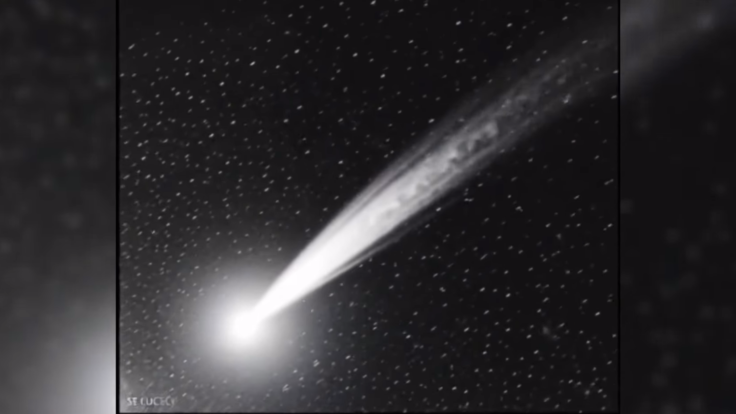NASA Releases New 3I/ATLAS Photos: Alien Spaceship Conspiracy Theory Fueled
NASA's 3I/ATLAS images fuel global intrigue and fresh alien spaceship theories.

NASA's release of new images of the interstellar comet 3I ATLAS has intensified public fascination and revived long-running claims that the object may be more than a natural visitor. The agency's latest multi-mission visuals were intended to bring clarity, yet they have instead widened speculation across online communities.
Global Anticipation for NASA's New Imagery
🚨 Two comets without tails in just weeks!
— 3I/ATLAS TV (@3iatlas_tv) November 9, 2025
3I ATLAS, an interstellar giant the size of Manhattan, lost its tail after passing the Sun on October 29, 2025 near Mars at 1.36 AU.
On November 3, 2025, new comet C/2025 V1 Borisov appeared from the Oort Cloud with eccentricity 1.009,… pic.twitter.com/ejARIU0m9e
NASA's decision to publish fresh photographs of 3I ATLAS followed months of pressure from space enthusiasts and sceptics alike. The comet, first identified hurtling through the solar system from an external origin, has maintained a grip on global attention because of its irregular behaviour and dramatic visual features.
The new set of images was derived from several observatories and monitoring programmes that tracked the object's motion and composition. The wide release was framed as an effort to support scientific transparency and to showcase the capabilities of current deep-space instruments.
Public excitement grew rapidly after the announcement, with major media outlets reporting that the new imagery could offer the clearest view yet of the comet's extended tails. The scale of international interest highlighted how interstellar objects have shifted from scientific curiosities to cultural phenomena. Each new development surrounding 3I ATLAS has fed that cycle, and the recent publication of images proved no exception.
Visual Features That Stirred Fresh Theories

The photographs presented a striking portrait of the comet's complex profile. Multiple tails appeared to fan outward as the object passed near a distant galaxy, creating a scene that observers described as unusually dramatic for a visitor of its size.
Specialists examining the images noted that such patterns can emerge from volatile materials reacting to solar radiation, combined with effects linked to the comet's speed and angle of approach.
Despite these explanations, the distinctive shape and symmetry of the comet's luminous trails reignited fringe claims that the object might contain artificial elements. The images' clarity allowed viewers to speculate on outlines and shadows that were consistent with their expectations rather than scientific evidence.
The timing of the release, combined with the rarity of interstellar bodies passing through the solar system, further encouraged those narratives to take hold. The enhanced resolution also contributed to public debate. Many casual observers felt that the visuals displayed features too clean or too precise to be random.
Scientists, however, stressed that advances in imaging technology have made such detail increasingly common, especially when tracking bright objects against deep-space backgrounds. The contrast between expert interpretation and public imagination once again demonstrated how scientific releases can shape discussions far beyond the laboratory.
How NASA Sought to Manage the Reaction
Astronomers have no idea what to make of the object 3I/ATLAS!
— 3I/ATLAS TV (@3iatlas_tv) November 8, 2025
This interstellar visitor behaved like a spacecraft -
it changed direction and released seven jets at once! 👇
Harvard’s Avi Loeb explains why 3I/ATLAS might not be just another ordinary object.
🎥 Watch the video… pic.twitter.com/hDwKCeAvnQ
NASA approached the publication with a strategy focused on research value and open access. By consolidating visual data from multiple instruments, the agency aimed to provide a comprehensive record for astronomers studying the composition and trajectory of interstellar travellers. The release also included technical notes on the processes used to assemble the images, adding context intended to reduce misinterpretation.
The agency faced a familiar challenge. High-profile space events often produce a split between scientific communication and online speculation. While NASA has historically addressed misconceptions through education and consistent updates, the rapid pace of social media can overshadow those efforts. This dynamic was evident as the new images spread and theories linking the comet to extraterrestrial design surged once again.
Across global news outlets, the focus remained on the scientific significance of the images and the broader pattern of interstellar objects arriving in the solar system. Researchers emphasised how such visits offer rare opportunities to study material shaped outside our planetary neighbourhood. Still, many outlets acknowledged the intense public interest in less conventional interpretations, a trend that has persisted since the first detection of 3I ATLAS.
NASA's latest release was designed to demystify one of the most watched celestial objects of the decade, yet it ultimately added new layers to the public narrative. The images expanded scientific understanding, but they also fuelled another wave of speculation that will likely continue as the comet moves beyond view and analysis shifts to archived data.
© Copyright IBTimes 2025. All rights reserved.




















